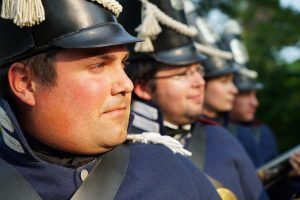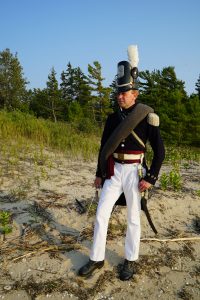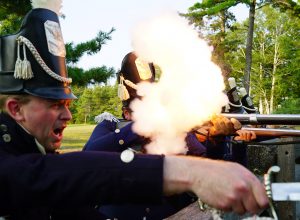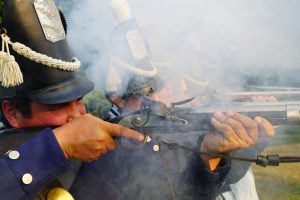

On August 4, 1814, war came to Mackinac Island. The island, which had been captured by the British in 1812, was now the focus of an American campaign to reclaim the region. That campaign reached its zenith as hundreds of American troops landed on the island’s north shore, marched inland, and encountered well-entrenched British, Canadian, and Native American troops.


After several false starts, the campaign to recapture Mackinac Island got underway from Detroit on July 3. Under the command of Lieutenant Colonel George Croghan, the American land forces included over 750 soldiers. These men sailed north aboard a fleet of seven U.S. Navy warships under the command of Commodore Arthur Sinclair. The fleet reached Mackinac Island on July 25 after raiding British outposts on St. Joseph’s Island and at Sault Ste. Marie. With many of his soldiers ill, Croghan hesitated for nearly a week anchored near Bois Blanc Island. Lieutenant Colonel Robert McDouall, commanding British forces at Fort Mackinac, used the delay to prepare for the attack he knew was coming. On August 3, Croghan and Sinclair finally prepared for a landing on Mackinac Island the next day, August 4.


The Battle of Mackinac Island lasted just over an hour, but cost the Americans 75 casualties, including 13 killed in battle and seven who died of their wounds. McDouall’s British and Native forces apparently lost no men. Croghan’s actions at Mackinac suggest that he was disinterested in launching what he presumed would be an unsuccessful assault on the British positions. Sinclair later admitted as much, writing that “Col. Croghan would never have landed, …being positive, as he was, that the Indian force alone on the island, with the advantages they had, were superior to him, could he have justified himself to his government, without having stronger proof than appearances, that he could not effect the object in view.” With the Battle of Mackinac Island lost, and an ensuing, clumsy attempt at a naval blockade easily overcome, the Americans retreated and left Mackinac firmly in British control. Only the treaty ending the War of 1812 returned Mackinac Island to the United States.










